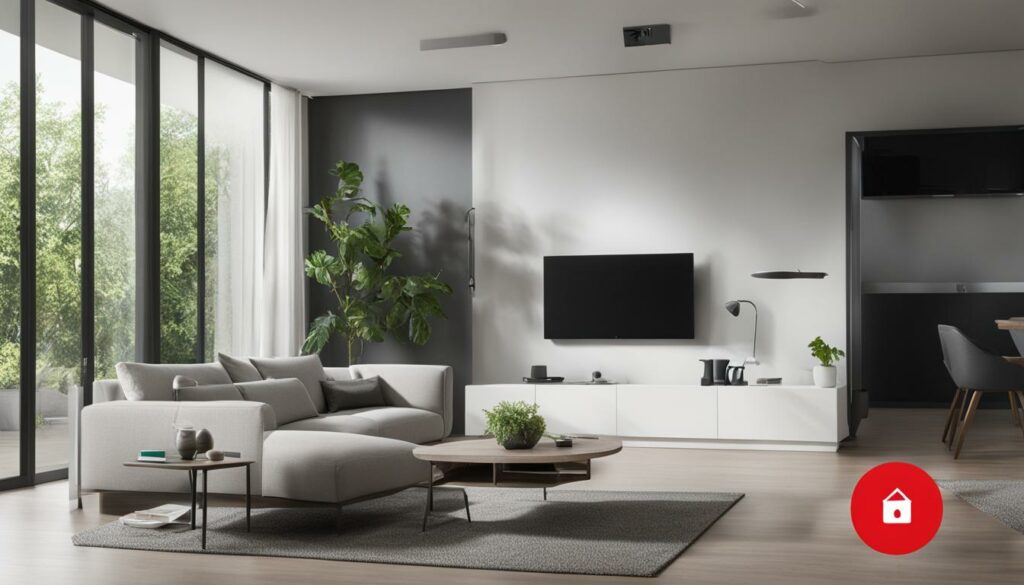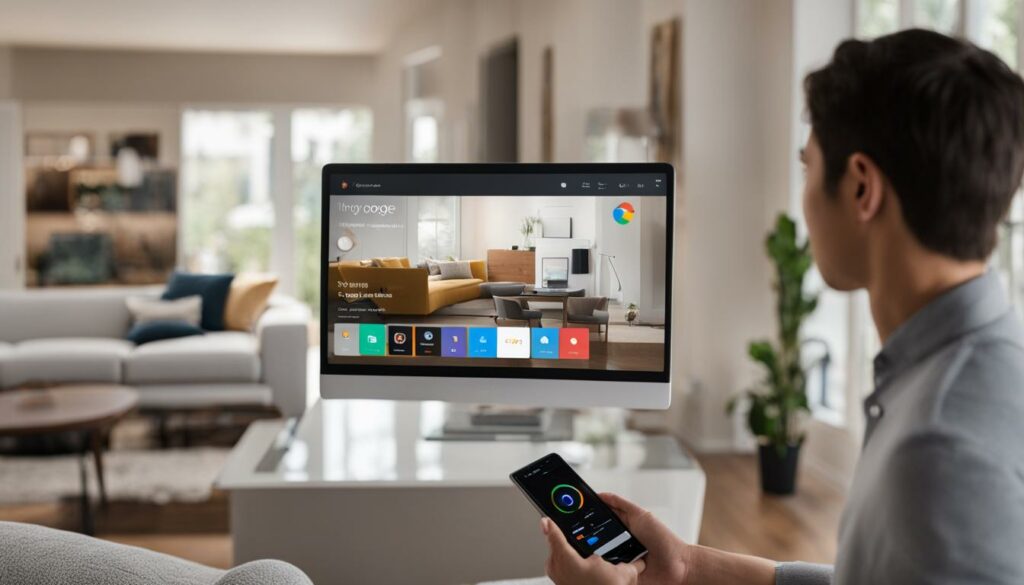Are you ready to step into the future of smart home automation? With the Matter smart home interoperability protocol, you can enjoy a seamlessly connected and integrated smart home experience. Matter eliminates the hassle of dealing with incompatible devices by creating a standard language that allows different platforms to work together harmoniously.
Whether you’re new to smart homes or already have a few devices, this setup guide will help you navigate the world of Matter smart home devices with confidence. From compatibility to integration and features, we’ve got you covered. Let’s dive in!
Key Takeaways:
- Matter is a next-generation smart home platform that aims to reduce fragmentation in the market.
- Matter devices communicate using Wi-Fi, Ethernet, Thread, or Bluetooth wireless technologies.
- Matter devices using Wi-Fi and Ethernet do not require a smart hub, but a Matter controller is needed for setup.
- Matter-enabled devices can function without an internet connection for local control.
- Compatibility with older devices depends on certification and updates.
What is Matter and how does it work?
Matter is a next-generation smart home platform that revolutionizes the way devices communicate. Developed through a collaboration between tech giants such as Apple, Amazon, Google, Samsung, and others, Matter aims to address the issue of fragmentation in the smart device market while enhancing security and reliability.
This innovative platform creates a standardized language that enables seamless interoperability among various smart home platforms. Matter leverages Internet Protocol (IP) networking, allowing devices to connect and share control effortlessly. Whether it’s a smart light bulb, thermostat, or security system, Matter ensures that different devices work harmoniously together.
Matter devices communicate using Wi-Fi, Ethernet, Thread, or Bluetooth wireless technologies, ensuring compatibility across a wide range of devices and networks. This flexibility ensures that you can easily integrate Matter-enabled devices into your existing smart home ecosystem without complications.
With Matter, the smart home experience becomes simpler and more cohesive. Gone are the days of worrying about whether a device is compatible or whether you need to invest in a specific hub for it to work. Matter streamlines the setup process and eliminates compatibility issues, making it easier for users to enjoy the full capabilities of their smart home devices.
Embrace the convenience and possibilities that Matter brings to your smart home setup, and unlock the true potential of your connected devices.
Key Features of Matter:
- Standardized language for seamless interoperability
- Supports various wireless technologies: Wi-Fi, Ethernet, Thread, Bluetooth
- Reduces fragmentation in the smart device market
- Enhances security and reliability
- Eliminates the need for specific hubs
“Matter creates a common language for smart home devices, enabling them to work together seamlessly and empowering users with greater control and convenience.” – [Matter Partner]
Do I need a smart hub to use Matter devices?
Matter devices using Wi-Fi and Ethernet do not require a smart hub to communicate. However, a Matter controller is still needed for the initial setup and control of the devices. The Matter controller can be any compatible device like a smartphone or smart speaker. For devices using Thread, a Thread border router is required. It is possible for a Matter controller and a Thread border router to be the same device. The availability and compatibility of Matter controllers and Thread border routers vary depending on the brand and model.
Will Matter work offline?

Matter-enabled devices offer offline functionality, allowing you to control and access them within your home even when there is no internet connection. These devices connect to your local network using Wi-Fi, Ethernet, or Thread, enabling them to function independently without relying on an internet connection.
When your internet is down, you can still enjoy the convenience of managing your Matter devices without interruption. Whether it’s adjusting the lighting, controlling the temperature, or unlocking your smart locks, you have local control over your smart home ecosystem.
Offline functionality not only ensures that you can continue to operate your Matter devices seamlessly but also provides several benefits. Firstly, it offers faster response times since the devices don’t need to communicate with a cloud server for processing. This means commands and actions executed locally can be executed more quickly. Additionally, local control enhances security and privacy as data is not transmitted over the internet or stored on third-party servers.
However, it’s important to note that while Matter-enabled devices can function offline, remote access and control when you’re away from home still require an internet connection. To manage your smart home ecosystem remotely, ensure that you have a stable internet connection.
Will older devices work with Matter?
The compatibility of older devices with Matter depends on their certification and support for the Matter protocol. While Matter aims to include as many devices as possible, it is necessary for devices to be certified and updated to be compatible with Matter. Some recent devices from popular brands like Google Nest, Amazon, and Samsung SmartThings have confirmed that they will add Matter functionality to their existing products, ensuring compatibility. However, not all devices will support Matter immediately, and it may take time for all brands to obtain certification and release updates. Matter certification for devices began in October 2022, and the first products with the Matter logo are expected to be available soon.
To give you a better idea of which devices are currently compatible, here is a list of some well-known brands that have committed to supporting Matter and adding compatibility to their existing products:
| Brand | Status |
|---|---|
| Google Nest | Addition of Matter functionality confirmed |
| Amazon | Addition of Matter functionality confirmed |
| Samsung SmartThings | Addition of Matter functionality confirmed |
Please note that this is not an exhaustive list, and other brands may also add Matter support to their devices in the future. However, it is important to be aware that not all older devices will be immediately compatible with Matter. Checking for the Matter logo and verifying device compatibility before purchasing or upgrading is crucial to ensure proper integration into your smart home system.
When can I use Matter-compatible devices?

The availability of Matter-compatible devices depends on the certification process and the release schedules of the manufacturers. The Connectivity Standards Alliance (CSA), which governs Matter, released the Matter 1.0 standard and opened the product certification program in October 2022. Brands must obtain certification before adding Matter support to their devices. The duration of the certification process may vary, but it is expected that consumers will start seeing products with the Matter logo in the near future. It is important to check for the Matter logo on the packaging and verify device compatibility before purchasing.
As the adoption of Matter-enabled devices grows, it is crucial to understand their availability and compatibility. The certification process ensures that devices meet the necessary standards to operate seamlessly within a Matter ecosystem. By checking for the Matter logo on the packaging, consumers can easily identify Matter-compatible devices and ensure compatibility with their existing systems.
Manufacturers are actively working towards obtaining Matter device certification, and product releases are expected to follow. As the rollout of certified devices progresses, consumers will have more options and a wider range of Matter-compatible products to choose from.
Matter Device Availability Overview
| Brand | Device Type | Matter Compatibility |
|---|---|---|
| Brand A | Smart Lighting | Expected Q1 2023 |
| Brand B | HVAC Controls | Currently Available |
| Brand C | Safety and Security Sensors | Expected Q2 2023 |
| Brand D | Door Locks | Currently Available |
| Brand E | Media Devices | Expected Q3 2023 |
*Availability dates are subject to change and may vary by region.
It’s essential to stay informed about the latest releases and updates from manufacturers to ensure compatibility with Matter-enabled devices. By embracing Matter technology, users can create a more integrated and efficient smart home system.
How to Set Up Matter-Enabled Devices with the Google Home App?

Setting up Matter-enabled devices with the Google Home app is a straightforward process. Follow these steps to get started:
- Open the Google Home app on your smartphone or tablet.
- Tap the “+” icon to add a new device.
- Select “Set up device” and choose the “Works with Google” option.
- Scroll down and tap on the Matter logo to continue.
- Make sure your Matter-enabled device is in pairing mode.
- The app will search for nearby devices. Once it detects your device, select it from the list.
- Follow the on-screen instructions to complete the setup process. This may include entering Wi-Fi network credentials.
- Once the setup is complete, you can assign a room and customize settings for the device within the Google Home app.
- You can now control your Matter-enabled device using voice commands or the Google Home app.
Setting up Matter-enabled devices with the Google Home app is a seamless experience that allows you to easily integrate these devices into your smart home ecosystem.
Why Choose the Google Home App for Matter Setup?
The Google Home app provides a user-friendly interface that simplifies the setup process for Matter-enabled devices. It offers a centralized hub for managing and controlling all your smart home devices, including those using the Matter protocol. With the Google Home app, you can easily set up, configure, and control your Matter-enabled devices in one place.
The above image depicts various Matter-enabled devices, showcasing the wide range of products available for a smart home setup.
Managing your Matter-enabled devices with the Google Home app

With the Google Home app, you have complete control over your Matter-enabled devices. Whether you want to change the nickname, assign a device to a different room, or move it to another home, managing your devices is easy and convenient.
To change the nickname of a device, simply touch and hold its tile in the Google Home app. Then, tap “Settings”, followed by “Name”. You can enter a new name that is more descriptive or personalized to suit your preferences.
If you want to assign a device to a different room, once again, touch and hold the device’s tile. Then, tap “Settings”, and select “Room”. Choose a new room from the list or create a new one if needed. Tap “Next” to confirm the change.
Need to move a device to a different home? The process is just as simple. Touch and hold the device’s tile, go to “Settings”, and select “Home”. From there, choose a different home and room for the device. It’s a quick and hassle-free way to keep your smart home organized.
Additionally, if you no longer need a Matter-enabled device connected to the Google Home app, you can remove it easily. Just touch and hold the device’s tile, go to “Settings”, and select “Remove device”. Confirm the removal, and the device will be disconnected from the app.
Managing your Matter-enabled devices has never been easier thanks to the intuitive interface of the Google Home app. Take full control of your smart home and customize it according to your preferences and needs.
Setting up smart-home devices: Find good spots and pick names carefully
When it comes to setting up smart-home devices, finding the perfect spot and choosing the right names can make all the difference. Proper device placement and thoughtful naming conventions can enhance the performance, usability, and overall experience of your smart home.
First and foremost, consider the function of each device and identify the best location to optimize its performance. For instance, when installing smart lighting devices, strategically place them to ensure proper illumination throughout your space while avoiding glare or shadows. This will create a comfortable and inviting atmosphere.
Alongside device placement, selecting clear and distinctive names is essential, especially if you have multiple devices of the same type. This ensures that you can easily differentiate between them when giving voice commands or managing your smart home through an app.
When naming your devices, opt for clear and concise labels that are easy to remember. Avoid generic names or placeholders, as they can lead to confusion and frustration. Instead, be specific and descriptive. For example, if you have multiple smart speakers, you could name them “Living Room Speaker,” “Kitchen Speaker,” or “Bedroom Speaker.”
By taking the time to find suitable spots for your devices and choosing carefully thought-out names, you can streamline your smart home experience and make it more user-friendly.
Benefits of Thoughtful Device Placement and Naming
The strategic placement of devices and the careful selection of names offer several advantages:
- Optimized functionality: Proper placement ensures that devices perform their intended functions efficiently and effectively, providing you with the desired results. It also minimizes the risk of interference or performance issues caused by suboptimal positioning.
- Seamless control: Clear and concise device names enable effortless control and management through voice assistants or smart home apps. With distinct names, you can easily address a specific device without confusion or mistakes.
- Enhanced usability: Thoughtful placement and labeling make it intuitive and convenient to operate your smart home. You can quickly locate and interact with devices, improving the overall user experience.
- Efficient troubleshooting: When devices are appropriately placed and labeled, identifying and resolving issues becomes simpler. With clear names and organized placement, troubleshooting becomes less time-consuming and more effective.
In summary, taking the time to find suitable spots for your devices and choosing clear and distinctive names can significantly enhance your smart-home setup. This attention to detail simplifies device control, improves usability, and ensures optimal functionality throughout your smart home.
Grouping, automation, and routines: Simplify your smart home experience
Grouping, automation, and routines are powerful features that can simplify and enhance your smart home experience. With these capabilities, you can streamline your control over multiple devices and create personalized scenarios that cater to your needs. Let’s explore how these features can transform your smart home setup:
Grouping: Control multiple devices with a single command
Grouping allows you to manage multiple devices simultaneously, eliminating the need to control each device individually. By creating device groups, you can issue a single command to control all the devices in that group. For example, you can create a group called “Living Room” that includes smart lights, a thermostat, and a media device. When you say, “Turn on the Living Room,” all the devices in that group will respond accordingly. This makes it easy to set the mood or adjust settings across an entire room with minimal effort.
Automation: Define rules and triggers for seamless control
Automation empowers you to define rules and triggers for your smart home devices, enabling them to perform actions automatically. For instance, you can schedule your smart lights to turn on at sunset, so you always come home to a well-lit environment. You can also create triggers based on specific conditions, such as having your thermostat adjust the temperature when you leave the house. Automation allows you to enjoy a hands-free experience, leaving the control of your devices to predetermined settings that suit your lifestyle.
Routines: Combine multiple actions into a single command
Routines provide a powerful way to combine multiple actions into a single command or trigger. With routines, you can create personalized scenarios that encompass various device interactions. For example, you could create a “Goodnight” routine that turns off all lights, locks the doors, and adjusts the thermostat to your preferred sleep temperature. By issuing a simple command like “Goodnight,” you can effortlessly prepare your home for a restful night’s sleep. Routines enable you to streamline your smart home interactions and make complex sequences of actions simple and convenient.
These features can be accessed and configured through the smart home app or voice assistants. Whether you prefer using your smartphone, tablet, or voice commands, grouping, automation, and routines provide a seamless and intuitive way to simplify your smart home experience.
Comparison of Grouping, Automation, and Routines
| Feature | Description |
|---|---|
| Grouping | Control multiple devices together with a single command. |
| Automation | Set up rules and triggers for devices to perform actions automatically. |
| Routines | Combine multiple actions into a single command or trigger for convenience. |
Moving or changing routers: What to do with your smart-home setup
If you are planning to move or change routers in your home, it’s important to consider the impact on your smart-home setup. Here are a few things to keep in mind when dealing with these situations.
1. Moving to a new location
If you are moving to a new home, you will need to reconnect and set up your smart-home devices in the new location. Follow these steps to ensure a smooth transition:
- Reset and reconfigure your devices: Refer to the manufacturer’s instructions to reset and reconfigure your smart-home devices. This may involve putting the devices in pairing mode or following specific steps to establish a connection.
- Update network settings: Once your devices are reset, update the network settings in your smart-home app or assistant to reflect the new Wi-Fi network in your new home. This will allow your devices to connect to the new network and regain functionality.
- Reposition devices if needed: Take the opportunity to reassess the placement of your smart-home devices in the new location. Consider factors such as signal strength, range, and accessibility to optimize their performance.
2. Changing routers in your current home
If you are changing routers within your current home, you may need to reconnect your smart-home devices to the new network. Here’s what you should do:
- Configure your new router: Set up and configure your new router following the manufacturer’s instructions. Ensure that your new router is properly connected to the internet.
- Reconnect your devices: For some devices, you may need to go through a reconnection process to establish a connection with the new router. This may involve entering the Wi-Fi network name and password or following specific steps provided by the device manufacturer.
- Firmware updates and additional setup: Some devices may require firmware updates or additional setup steps to connect to the new router. Check the manufacturer’s support documentation or website for any specific instructions or updates related to your devices.
- Update network settings: Once your devices are connected to the new router, update the network settings in your smart-home app or assistant to reflect the new Wi-Fi network. This will ensure proper communication between your devices and the app or assistant.
If you encounter any issues during the moving or router changing process, consult the device manufacturer’s support documentation or reach out to their customer support for further assistance.
| Considerations when moving or changing routers: |
|---|
| Reset and reconfigure devices |
| Update network settings |
| Reposition devices if needed |
| Configure new router |
| Reconnect devices |
| Check for firmware updates |
| Update network settings |
By following these guidelines, you can ensure a seamless transition for your smart-home setup when moving or changing routers.
Conclusion
The Matter smart home protocol is poised to revolutionize the future of smart home automation. With its focus on reducing compatibility issues and fostering seamless integration, Matter offers a promising solution for creating a connected and intelligent home environment. Whether you are a tech-savvy enthusiast or just dipping your toes into the world of smart devices, Matter-enabled devices provide a user-friendly experience that can be easily set up and controlled through platforms like the Google Home app.
One of the key benefits of Matter is its standardization and interoperability. By establishing a common language for different devices and platforms to communicate, Matter allows for greater flexibility and choice when building your smart home ecosystem. Gone are the days of being restricted to a single brand or platform – Matter opens the doors to a wide range of compatible devices, enabling you to create a customized smart home that suits your needs.
Looking to the future, the support and certification for Matter-enabled devices is constantly expanding. This means that users can expect a growing selection of products and improved integration as more manufacturers come on board. Embracing Matter technology not only simplifies your life by providing centralized control over your devices, but it also unlocks the full potential of your smart home with enhanced compatibility and functionality.
In conclusion, Matter is paving the way for a smarter and more connected future. Its benefits lie in its ability to reduce fragmentation, offer interoperability, and provide a seamless user experience. By embracing Matter-enabled devices, you can make your home smarter, more efficient, and more enjoyable, while enjoying the peace of mind that comes with industry-standard security and reliability. The future of smart homes is bright, and Matter is at the forefront of this exciting journey.
FAQ
What is Matter and how does it work?
Matter is a next-generation smart home platform that connects devices using Internet Protocol (IP) networking. It creates a standard language that allows different smart home platforms to work together and share control over devices. Matter devices communicate using Wi-Fi, Ethernet, Thread, or Bluetooth wireless technologies.
Do I need a smart hub to use Matter devices?
Matter devices using Wi-Fi and Ethernet do not require a smart hub to communicate. However, a Matter controller is still needed for the initial setup and control of the devices. The availability and compatibility of Matter controllers and Thread border routers vary depending on the brand and model.
Will Matter work offline?
Matter-enabled devices can work offline to some extent. They connect to the local network using Wi-Fi, Ethernet, or Thread, which allows them to function without an internet connection. However, for remote access and control when you’re away from home, an internet connection is required.
Will older devices work with Matter?
The compatibility of older devices with Matter depends on whether they are certified and updated to support the Matter protocol. Matter certification for devices began in October 2022, and the first products with the Matter logo are expected to be available soon.
When can I use Matter-compatible devices?
The availability of Matter-compatible devices depends on the certification process and the release schedules of the manufacturers. Brands must obtain certification before adding Matter support to their devices. Consumers can expect to see products with the Matter logo in the near future.
How to set up Matter-enabled devices with the Google Home app?
To set up Matter-enabled devices with the Google Home app, follow the instructions provided in the app. The setup process may vary depending on the specific device and brand.
Managing your Matter-enabled devices with the Google Home app
With the Google Home app, you can easily manage and control your Matter-enabled devices. You can change the nickname, assign the device to a different room, or move it to a different home within the app.
Setting up smart-home devices: Find good spots and pick names carefully
When setting up smart-home devices, consider the device’s function and the best location to achieve optimal performance and usability. When naming devices, choose names that are easy to remember and differentiate, especially if you have multiple devices of the same type.
Grouping, automation, and routines: Simplify your smart home experience
Grouping allows you to control multiple devices together with a single command. Automation enables you to set up rules and triggers for your devices to automatically perform certain actions. Routines combine multiple actions into a single command or trigger.
Moving or changing routers: What to do with your smart-home setup
When moving, you will need to reconnect and set up your devices in the new location. If you are changing routers, you may need to reconnect your devices to the new network. Follow the manufacturer’s instructions to reset and reconfigure the devices.
